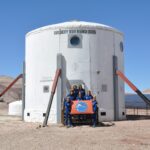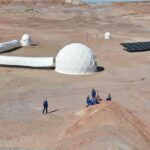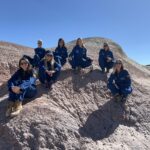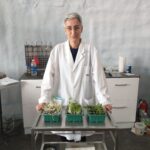[category science-report]
Crew 280 End-of-Mission Research Report
Astronomy
Over this past week, the MDRS astronomical facilities have provided a unique opportunity to observe the Martian night sky under limited light pollution. Taking advantage of these great conditions, Mariona Badenas-Agusti (Crew Commander and Astronomer) is combining her leadership and management responsibilities at the MDRS with two astronomy-related projects:
-
Study of the Solar Chromosphere [External Point of Contact: Mr. Peter Detterline]: The goal of this project was to use the Lunt 1000mm refracting telescope in the Musk Observatory to study the chromosphere of the Sun. During the first days of the mission, the telescope was not properly aligned, so Mariona had to spend some time understanding how to calibrate it properly. After this issue was resolved, she was able to conduct visual observations of the Sun and identify a variety of magnetic phenomena, including sunspots, flares, and granules. To date, she has been able to identify various sunspots through the telescope’s eyepiece.
a variety of planetary nebulae (NGC 6888/Crescent Nebula, NGC 6853/Dumbbell Nebula) and galaxies (NGC 4273, NGC 5371, NGC 5033, NGC5055/Messier 63, and NGC 3184/Little Pinwheel Galaxy). After returning to the Earth, she will process her observations and share her final color images with the general public.
Biology
The Hypatia I crew has several biology-related projects in the fields of microbial, animal and human sciences. The MDRS provides a unique environment to conduct such projects: first, it allows us to study how humans and microbial life would develop on Mars; and second, the MDRS’ exterior environment is a good place to search for potential “Martian” biological signatures.
Carla Conejo González (Crew Executive Officer & Biologist) has combined her Executive Officer responsibilities at the MDRS with projects on humans factors affecting a mission to Mars, including experiments in the fields of neurosciences, psychology, sociology and gynecology, in collaboration with different European institutions:
-
Circadian rhythms in a Mars analog mission [External Point of Contact: Dr. Jorge Abad, Hospital Germans Trias i Pujol, Spain]: The goal of this project was to study the sleep-wake cycle of the crew and how their participation in a Martian analog mission at the MDRS has affected their circadian rhythms. The project had two different
approaches: (i) the telemetric approach, where each crew member’s sleep record was tracked using an actigraphy wearable wrist-worn device (Fitbit® by Google) and complemented by 4 out of 7 participants with an automatic video analysis using the beta-version of a mobile app (SleepWise®) ; (ii) the same register was recorded using a written sleep log diary, where each crew member wrote down when they went to sleep and woke up, as well as their self-perception of sleepiness during the day. Both digital and analogic records will be analyzed after the mission.

-
Psychology [External Point of Contact: Michel Nicolas, PhD, Professor at University of Burgundy, France]: The goal of this subproject was to better understand the psychological adaptation to isolated and confined extreme conditions during a space mission simulation, and its repercussions on individual, social and organizational features. The data collection has been performed using 10-minutes questionnaires that the crew filled up on a daily basis.
subproject was to study the social interactions of the crew to optimize its performance. The data collection consisted of 5-minutes questionnaires that the crew filled up twice a week, after which the crew received a report from the company including a visualization of the social structure of the crew and suggestions for improvement.
-
Gynecology [External Point of Contact: Dr. Joaquim Calaf, Emeritus Chairman of Obstetric and Gynaecology of the Hospital of Sant Pau, Spain]: The goal of this subproject was to study changes in the ovarian function of an all-female crew subjected to the experimental situation of participating in a 15-day Martian analog mission at the MDRS. Data collection was performed with 5-minutes questions that the crew filled up pre-mission and in specific moments during the mission determined by their period.
Laia Ribas (Green Hab Officer & Biologist) was combining her daily responsibilities in the GreenHab with her research projects. Her projects are summarized below:
-
CatMart [External Point of Contact: Marisa Flanneris, soil scientist at MicrobioMeter; Maria Matas, Director of La Marinada School, El Masnou, Barcelona]: This is an outreach project aimed at identifying microorganisms on Mars. A total of eleven Martian spots were sampled, obtaining a total of 100-300 g of soil. In particular, sand was collected from Cowboy Corner (sampled on 20/03/23); Kissing Camel River (sampled on 21/03/23) ; Robert Garden Rock (sampled on 21/03/23); North Ridge (sampled on 22/03/23) ; Compass Road (sampled on 23/03/23); White Rock Canyon (sampled on 25/04/2023); Barrainca Butte (sampled on 25/04/2023); the area around the MDRS Hab (sampled on 26/04/2023); Brahe HWY1572 (Down Hill sampled on 26/04/2023); Brahe HWY1572 (Up Hill sampled on 26/04/2023); and Marbel Ritual (sampled on 27/04/2023). The soil samples, kept in zipper plastic bags, were brought to the station for further analysis during the remaining SOLs. The microorganisms were tested by a commercial kit (MicroBiometer, USA). Results showed the presence of microorganisms (bacteria and fungus) in seven out of the eleven Martian soil sampled at the Martian desert while the other four, no Martian life was able to detect. The highest ratio of those microorganisms detected by the kit belonged to bacterial burdens. The level of microrganisms were 52 µg C/g (White Rock) to 115 µg C/g (Robert Garden). Soil from the Green Hab was used as positive control (432 µg C/g).

-
Aquaculture on Mars. [External Point of Contact: Roger Anglada, sequencing services at University Pompeu Fabra, Barcelona]. The aim of this project was to study the alteration of the epigenome in zebrafish subjected to hypergravity. The experiments were conducted at the Institute of Marine Sciences (ICM-CSIC, Barcelona). This project is at the forefront of high-sequencing
technology through the use of an instrument called MinION. Unfortunately, due to the delivery of the products and the samples, the FlowCells needed for sequencing were not in optimal conditions therefore, the project was stopped. Nevertheless, we are continually studying the technique as it will be used in the Ribas’ Lab in Barcelona.
-
Martian Bottle [External Point of Contact: Helena Arias, Bottle designer and Hypatia I crew; Marisa Flanneris, soil scientist at MicrobioMeter]. The aim of the experiment was to reduce the number of microorganisms in the water. The
water was obtained from the waste watering in the GreenHab. Three experiments were performed based on different exposition times and temperatures (4ºC and Room Temperature). The figure on the right shows one step of the protocol in which the residual water is diluted (right side in the figure) and divided into two experimental groups, the control (middle) and the Martian bottle (left). Microrganisms were detected by using a commercial kit (MicroBiometer, USA). Unfortunately, none of the three experiments showed a decreased of the level of microorganisms in comparison with the control group. Therefore, further experiments need to be performed.

Cesca Cufí (Crew Engineer) is combining her duties as engineer with an engineering and biology project. The biology project consists of:
-
Cellular intelligence on Mars [External Point of Contact: Dr. Audrey Dussutur, CNRS]: This research project aimed at studying the influence of UV, IR radiation and gravity on the exploration behavior and sporulation triggering of physarum polycephalum. Physarum polycephalum, commonly known as “blob”, is an example of plasmodial myxomycetes that consists of a multinucleate single cell amoeba-like organism. This curious creature shows rare learning capabilities for a single celled organism. It is capable of memorizing its previous path and of finding the optimum one towards the food sources. Slime molds are not only surprising for its learning capabilities but for being extremely resistant. However, physarum has shown to be very sensible to light. This research can give us some clues on how life on Mars can be developed and moreover, lighten great questions about life development on Earth before the formation of the current atmosphere. Three sclerotia of physarum polychefalum (LUT strain) were cultivated and grown until big enough to provide 4 clones to be tested simultaneously in different conditions:
-
One sample being the control sample, with no stimulation.
-
A second sample on an inclined plate to evaluate the effect of gravity.
-
A third one being stimulated with IR light.
-
And finally, a fourth sample, stimulated with UV light.
The temperature in the Science Dome was above 20ºC, the maximum temperature for an optimal test. The temperature, together with the low humidity, complicated the cultivation of the physarum and the tests. A malfunction of the cabin (see Engineering part) didn’t allow to have concluding results. The experiment will be conducted back on Earth and further developed.
Engineering
Dr. Ariadna Farres Basiana (Scientist & Health and Safety Officer) is combining her Health & Safety Officer duties at the MDRS with an astrodynamics and navigation project:
-
Martian GPS: The goal of this project was to study the feasibility of a low-cost GPS network around Mars. First, we replicated Earth’s GPS around Mars by adjusting some of the orbital parameters, like the semi-major axis (sma) and the Right Ascension of the Ascending Node (RAAN), to ensure the same type of coverage around the Martian surface. This network requires at least 24 satellites, in 6 orbital different orbital planes, which is far from low-cost, however this ensures a 24h hours coverage on most parts of the Martian surface. Second, we worked on reducing the number of satellites to 6 placed in 3 different orbital planes, which ensures 24h coverage around Chryse Planitia (“Golden Plane”) where we have established our Martian base. Further orbital configurations must be studied to reduce the number of satellites. All the simulations have been done using NASA’s open-source software GMAT (General Mission Analysis Tool).

-
How do we navigate? The idea behind this project is to remember how our ancestors used to find their way around the world. Now we strongly rely on GPS and have forgotten how to interpret a map. But when we get to Mars, we will probably need to do the same. We already started exploring the cost of building a Martian GPS, but how can we orient ourselves on the Martian surface without this more advanced technology? Two different activities have been studied for this purpose.
-
Building a Sextant: A sextant is a navigation instrument used to measure the angle between any two visible objects. It is commonly used in navigation around the sea to determine the angle between the horizon and a celestial body, such as the sun or stars, to calculate our latitude and longitude. Mars rotation axis has an inclination of 25 deg, very similar to the one from Earth, hence the night sky is very similar, and we could also point a sextant towards Polaris to determine our latitude on Mars.
We built an in-house sextant using a material that was available inside the base, such as a ruler, a home-made protractor, a string, and a rock. We checked the precision of our sextant trying to determine the MDRS latitude, we had an error of 4 deg, which we considered a success.
-
Navigation Exercise: Being able to orient yourself on Martian terrain will be determinant for future astronauts. We developed a navigation exercise, with the excuse of a rescue mission, the crew members had to find 4 beacons around Robert’s Rock Garden, following a map and written instructions. Two crew members (Arianda Farres and Cesca Cufi) identified landmarks and placed the beacons in the field and wrote down the exercise. The rest of the crew was split into two different groups that performed the exercise in two different EVAs. Both groups managed to finish the exercise in less than 40 min.
Cesca Cufí (Crew Engineer) is combining her duties as engineer with an engineering and biology project. The engineering project is summarized below:
-
“The Blob’s house”: This project consisted of designing and constructing a prototype of a biologically safety cabin to perform biological experiments in the context of an analog mission where biocontamination has to be prevented. The cabin features were specifically designed for the biological experiment with the physarum polycephalum (commonly known as “blob”). It contained 4 light boxes equipped with a camera and a LED light each. Two of the boxes contained a PCB, one with a IR emitter and the other one with a UV emitter. The current provided to these emitters reproduced the radiation that reaches the Martian surface. The cameras and LEDs were controlled with a raspberry pi. The cabin also contained a venting system with two fans that activated depending on the temperature of the cabin, provided by a temperature and humidity sensor. The venting system was equipped with filters (membrane) to prevent external agents to enter the cabin as well as interior organisms to pollute the exterior. The sensor and the fans were controlled with an arduino. The arduino data was transferred to the raspberry pi to be registered. Every 4 minutes the LEDs were switched, a picture was taken and the temperature and humidity was registered. The cabin was lightweight and fully demountable.
The cameras presented a bug that had not been observed before when using the cabin on Earth. This bug was triggered randomly in one of the cameras, when the system was commanded to take a picture with the lights on. This bug prevented the lights to turn off, over stimulating the samples and therefore resulting in non representative results. We are working to investigate and solve this issue.

Dr. Neus Sabaté (Mission Specialist) is assisting the Crew Engineer of the mission and performing her Engineering experiments related to battery development:
-
Martian batteries development: The goal of this project was to use iron-based rocks present in Mars (or in the MDRS surroundings) as main components to build-up primary batteries as on-site power sources for a future mission to Mars. To evaluate the feasibility of this approach, Sabaté proposed three different subprojects:
-
Extraction of electroactive Fe ions from rocks [External Point of Contact: Dr. Angels Canals, Professor at the Earth Sciences Faculty from University of Barcelona] Four different locations (Marble Ritual, Compass Rock,Robert’s Garden Rock and Barainca Butte) were explored and in two of those locations (Marble Ritual and Barainca Butte) Sabate found soundstone rock, siltstone and argillite. The rock samples were immersed in diluted HCl for a few days in order to extract the Fe3+ and Fe2+ ions. Presence of Fe3+ ions was found in the solutions with immersed argilite samples, proving that it is possible to extract electroactive ions from the rocks with a simple chemical procedure. The method used to identify Fe3+ presence was electrochemical cyclic voltammetry with a portable potentiostat.
-
Optimized martian batteries operation. As a proof of concept, Sabaté also mounted and characterized 3 batteries based on iron-chemistry. In this case, as the quantity of iron obtained per rock was very small, additional iron was brought from Earth in two different formats: iron bars (Fe(0) state) as battery anodes and ferric chloride salts (Fe3+) as cathodic species. The batteries were mounted in series and filled up with salty water. After this first test, water was substituted by urine’s crew, as a way to minimize water consumption and proof that it is possible to use this liquid as an alternative to water for power generation. The energy generated with the batteries has successfully powered a small LED module that stimulates seed growing during five days
-
Growing seeds with artificial LED lighting. In order to show a visual and understandable application of the project, the martian batteries were tailored to match the power needs of a LED module. Sabaté planted seeds in three different desktop hotbeds that were submitted to different conditions: one hotbed was placed next to the Science Dome window and received sunlight during the day, another hotbed was placed inside a camping storage cupboard and was in
complete darkness whereas the last one received LED lighting (powered by iron-based batteries) from 8:00am to 8:00pm. Experiments were conducted during 5 days. The results were conclusive: LED lighting stimulates growth and allows green sprouts to grow in very short periods of time!

Outreach and Communication
Núria Jar (Crew Journalist) was reporting on the field the experience of Hypatia I at the MDRS. Her main projects are summarized below:
-
Daily journalist reports for the MDRS explaining the day at the base.
-
Taking photographs for the “Photograph of the day” report, requested by the MDRS.
-
Daily audio reports about Hypatia I crew’s experience at the MDRS for the Catalan public radio station Catalunya Ràdio.
-
Recording featured interviews and sounds recorded during the mission for her podcast “Sounds of Mars”, which will be released by Catalunya Ràdio.
-
Filming some interesting scenes of Hypatia I daily routine to document the experience.
In addition, she is also working on a future book about the mission to inspire young girls to pursue STEAM-related careers, as the Hypatia crew members did.
Carla Conejo González (Crew Executive Officer & Biologist) is also conducting a communication project consisting of a video diary of the mission that will be released after the mission. In addition, she is giving support to the outreach projects of her crewmates.
Ariadna Farrés Basiana (Scientist & Health and Safety Officer) is also conducting an outreach activity called in collaboration with St. Peter’s School in Catalonia. The goal is to study the effect of the space environment on Tomato seeds. We got two sets of tomato seeds: one set of seeds had spent 5 weeks in the International Space Station (ISS), while the other set of seeds stayed on Earth. These seeds were provided by TomatoSphere, and we have no prior
information of which set of seeds went to space. We planted the two sets of seeds on Sol 2 (8 seeds per set) and monitored them throughout the ten remaining Sols. The first set (V) started sprouting on Sol 8, while the second set (W) sprouted on Sol 10. At the end of the mission we had 5 seed form set V and 3 seeds form set W. We will now submit these results and find out which set of seeds went to the ISS.
Laia Ribas (Green Hab Officer & Biologist) has created a card game inspired by the Hypatia I crew and their Martian mission at the MDRS. This game has been created by the Lastuf company and the illustration of the cards was made by Anna Back, the Backup Scientist and Artist-in-Residence of Hypatia I. The game is available in multiple languages.


































You must be logged in to post a comment.